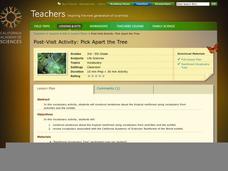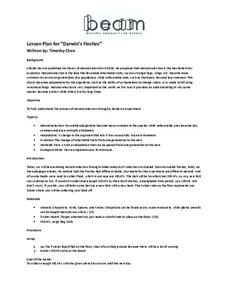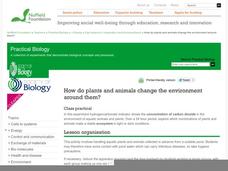Curated OER
3-D Cell Model
Life science laureates choose a plant or animal cell to construct a model of as an at-home project. This handout provides guidelines, suggested materials, and a grading rubric for their reference. A full-page letter to parents is also...
Pleasant Valley Community School District
Integumentary System
This document can be used as a slide show to introduce your human body systems class to the integumentary system, also know as skin. Topics outlined include the roles of skin, details about its its layers, and color (cause and...
Curated OER
The Five Senses
Teaching little ones about their five senses is always a fun experience. Accent your classroom with a fun image that shows real pictures of real kids hearing, seeing, smelling, tasting, and touching.
Curated OER
Reproductive System Crossword
High schoolers review the male and female reproductive systems and fetal development with this crossword puzzle. Some of the answers are vocabulary terms for given definitions, while some are fill-in-the-blank. There are 39 spots to...
Coastal Carolina University
Osmosis and Diffusion Lab: Honey I Blew Up the Bear
Beginning biologists explore passive transport through two demonstrations and a hands-on inquiry. Spray air freshener from one spot in the classroom and have class members raise their hands as the scent reaches them. Also, place a teabag...
Baylor College
Servings and Choices
An important part of balancing caloric intake to energy expenditure is knowing how many Calories you are consuming. In the fifth of a seven-activity series on food and energy, learners estimate their daily caloric intake, then use a...
Baylor College
Making Copies of an HIV Particle
In the second of five lessons about HIV, discover the mechanisms that allow the HIV virus to replicate. Using the models that they created the day before, learners examine the parts of the virus particle. The lesson plan does not say...
Scholastic
Study Jams! Plants without Seeds
Non-vascular plants do not develop seeds in order to reproduce. There are also some vascular plants that do not put out seeds. By viewing and reading through these six slides, green thumbs learn about mosses, liverworts, and ferns. They...
Scholastic
Study Jams! The Senses: Smelling
It makes sense to sniff out a good lesson on the sense of smell. Here is a six-slide presentation that can be a strong component to that lesson! With photographs and expository graphics, life scientists find that smell is the detection...
Irish Osteoporosis Society
Osteoporosis
Osteoporosis has long been viewed as an "old ladies' disease," but there are many people at risk. There are also many things young people can do to reduce their risk factors. Learn about all of this and more through a comprehensive...
California Academy of Science
Pick Apart the Tree
In only 30 minutes, your class will have increased their rainforest vocabulary. They visualize the things they have seen on a recent trip to a rainforest exhibit. Then, they create sentences for each of the rainforest-related vocabulary...
Berkeley Engineering and Mentors
Darwin's Finches
Try a twist on the old finch beak and chopsticks activity by using M&Ms on a Twister mat. Spoons, knives, forks, and chopsticks represent beaks and are randomly assigned to your little birds, who must collect as much food as possible...
McGraw Hill
Chapter 21: Mammals
Although the worksheet found here is designed to accompany a particular textbook reading, it is a good basic review or study guide when learning about mammals. If you have a text that covers these concepts, young scientists can use the...
Science Days
My Fingerprints
Here is a very simple worksheet that offers learners the opportunity to put their fingerprints on two blackline shapes of hands. A great tool to use when teaching little ones about their unique and individual prints. Tip: Have learners...
Curated OER
Plant Structure and Function
With a few minor formatting changes, the plant parts and processes resource here would make a great study guide, quiz, or self assessment. Currently, it is a bit confusing, but changing some lettering to numbering would clear up any...
Curated OER
Breathing
When learning about the respiratory system, how do learners know what is important? One way is to use a self-assessment or study like the one found here. While the formatting could use some work, the concepts are solid. Depending on your...
Institute for Systems Biology
Introduction to Saline Environments & Microbial Halophiles
If you do not mind wading through unrelated headings (This is not for a physics or STEM course, as it states.) and content (The lesson opens with an article about neurology, not halophiles.), then you will find a valuable resource on...
Curated OER
Ecosystems
With a variety of multiple choice and short answer questions, the handout found here could be used in many ways in the classroom: pretest/posttest, study guide, reading guide, or entry/exit questions. There is not a lot of space for...
Curated OER
Celery Lab
How do sugar and salt affect celery's mass, width, and flexibility? Using simple household ingredients, young scientists will perform a controlled experiment to find out. The lab is scaffolded through a worksheet, but there are no other...
American Heart Association
Label the Heart's Parts
When learning about coronary anatomy, it is helpful to have a diagram. Here is a simple illustration of the heart ready to be labeled with the words at the bottom of the page. It could be used as a quiz, homework assignment, or completed...
Nuffield Foundation
Modelling the Human Ventilation System
Why is breathing so difficult for asthma sufferers? To find out, learners build their own lung models in the investigation (from a British website, hence the term ventilation system instead of respiratory system). Using different-sized...
Curated OER
Testing Leaves for Starch: the Technique
Like good scientists, kids often want to see first-hand why things are as they are; they can do just that in the starch-testing photosynthesis activity found here. Depending on the age of your pupils, you may wish to do the investigation...
Curated OER
How Do Plants and Animals Change the Environment Around Them?
If you have elodea and snails in your classroom aquarium, or if you have access to a pond with these organisms, your young biologists can set up a controlled experiment to determine how certain ecosystems respond in light and dark...
Nuffield Foundation
Biodiversity in Your Backyard!
Take your enthusiastic ecologists outdoors to explore the biodiversity right in their own schoolyard! In preparing for this activity, it may be worthwhile to research websites with local flora to help in the plant identification portion.
























